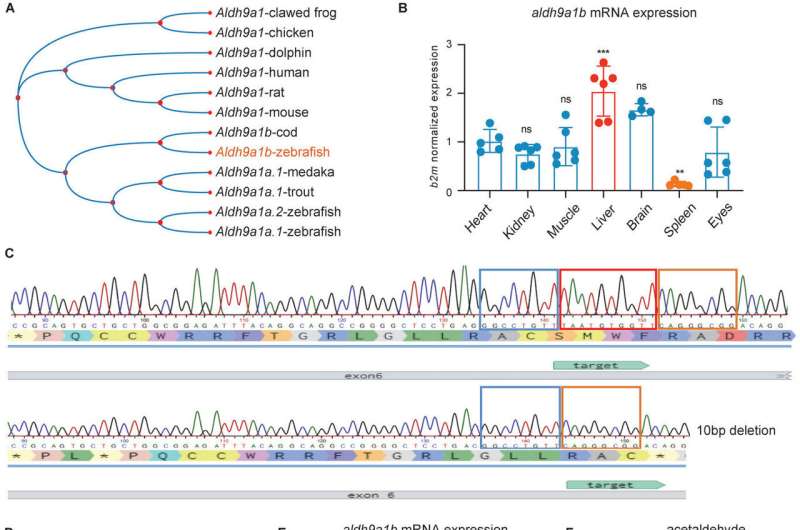This article has been reviewed according to Science X's editorial process and policies. Editors have highlighted the following attributes while ensuring the content's credibility:
fact-checked
peer-reviewed publication
proofread
Research offers new insights into how breakdown of omega-6 fatty acids influences metabolism

What role do omega-6 fatty acids play in cardiovascular disease and diabetes? Scientists from Mannheim, together with researchers from Heidelberg, Frankfurt, and Hangzhou in China, have investigated the breakdown of omega-6 fatty acids and gained new insights into how their oxidation products influence the metabolism.
The findings are published in the journal Advanced Science.
Under the leadership of Professor Dr. Jens Kroll from the European Center for Angioscience (ECAS) of the Medical Faculty Mannheim, Heidelberg University, the researchers identified a breakdown product of omega-6 fatty acids and developed a model in zebrafish to examine the undesirable effects of this oxidation product, known as tt-DDE (for trans,trans-2,4-decadienal).
While omega fatty acids are generally considered healthy, doubts are rising. Epidemiological studies and a so-called Red Hand Letter, in which eight pharmaceutical companies provide information on the risks associated with omega-3 fatty acids (source: BfArM, 16 November 2023), suggest that the issue is more complex than thought.
Like omega-3 fatty acids, omega-6 fatty acids are polyunsaturated fatty acids. And like these, they have various functions in the body and must be supplemented through diet. The role of omega-6 fatty acids in relation to cardiovascular disease is contradictory.
On the one hand, omega-6 fatty acids likely reduce the risk of developing cardiovascular diseases such as heart attacks or strokes by positively influencing lipid (fat) levels and blood pressure. However, an excess of these essential fatty acids is suspected of inducing early stages of vascular calcification through their pro-inflammatory effect and thus in turn, promoting cardiovascular disease.
New cause of side effects discovered
Professor Kroll's research group at the Medical Faculty Mannheim, Heidelberg University, together with scientists from Heidelberg University Hospital (UKHD), the University of Frankfurt and Zhejiang University Hangzhou, China, approached the topic from a new perspective by investigating the oxidation product tt-DDE, which is also abundant in cooking oil fumes.
In order to understand what increased tt-DDE levels can do, they first had to identify which enzyme is responsible for breaking down tt-DDE. They discovered that aldehyde dehydrogenase 9a1b performs this task: When this enzyme is inhibited, tt-DDE levels rise.
With this information, the scientists successfully developed a zebrafish model to explore the effects of high tt-DDE levels. They found that increased tt-DDE level is associated with a disruption of the sugar metabolism, similar to mild diabetes, as well as an impaired function and formation of blood vessels, which is also typical of diabetes.
The researchers also discovered the mechanism. They were able to prove that tt-DDE inhibits the function of the insulin receptor by binding to it. The blood sugar-lowering effect of insulin, which in a healthy individual activates the transport of glucose from the blood into the cell, cannot develop and is presumably responsible for the hyperglycemia observed in the blood.
Professor Kroll says, "We discovered a new function of aldehyde dehydrogenase 9a1b while investigating a breakdown product of omega-6 fatty acids. Since the enzyme regulates tt-DDE levels, it is also an important regulator of glucose metabolism and could be an important component in the development of diabetes. We now want to investigate whether there is a subgroup of people with diabetes who develop secondary damage due to excessive tt-DDE levels—either because tt-DDE breakdown is too low or tt-DDE accumulation due to oxidation of omega-6 fatty acids is too high."
This is followed by an important question that the scientists also want to investigate: Are there people with mild diabetes caused by a disorder of aldehyde dehydrogenase 9a1 function—and could aldehyde dehydrogenase 9a1 be the key to a new therapy?
With this work, Professor Kroll's research group has achieved an important milestone in understanding how oxidation products of omega-6 fatty acids influence metabolism, which may also shed some light on the somewhat more complex effects of omega fatty acids.
More information: Xin Qian et al, Impaired Detoxification of Trans, Trans‐2,4‐Decadienal, an Oxidation Product from Omega‐6 Fatty Acids, Alters Insulin Signaling, Gluconeogenesis and Promotes Microvascular Disease, Advanced Science (2023). DOI: 10.1002/advs.202302325





















